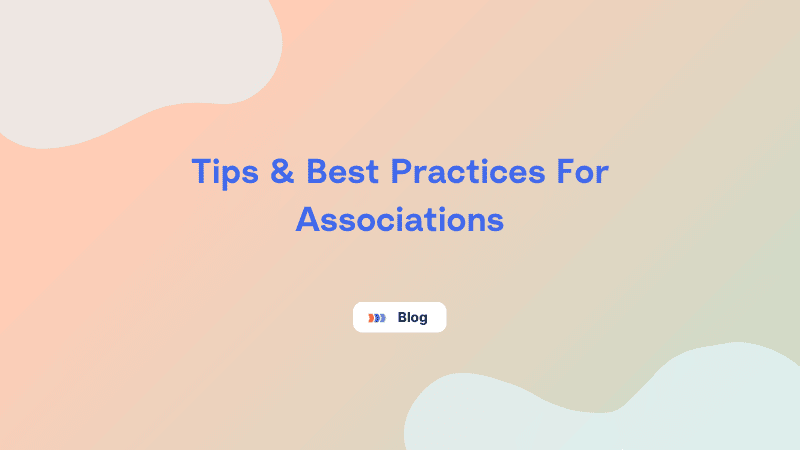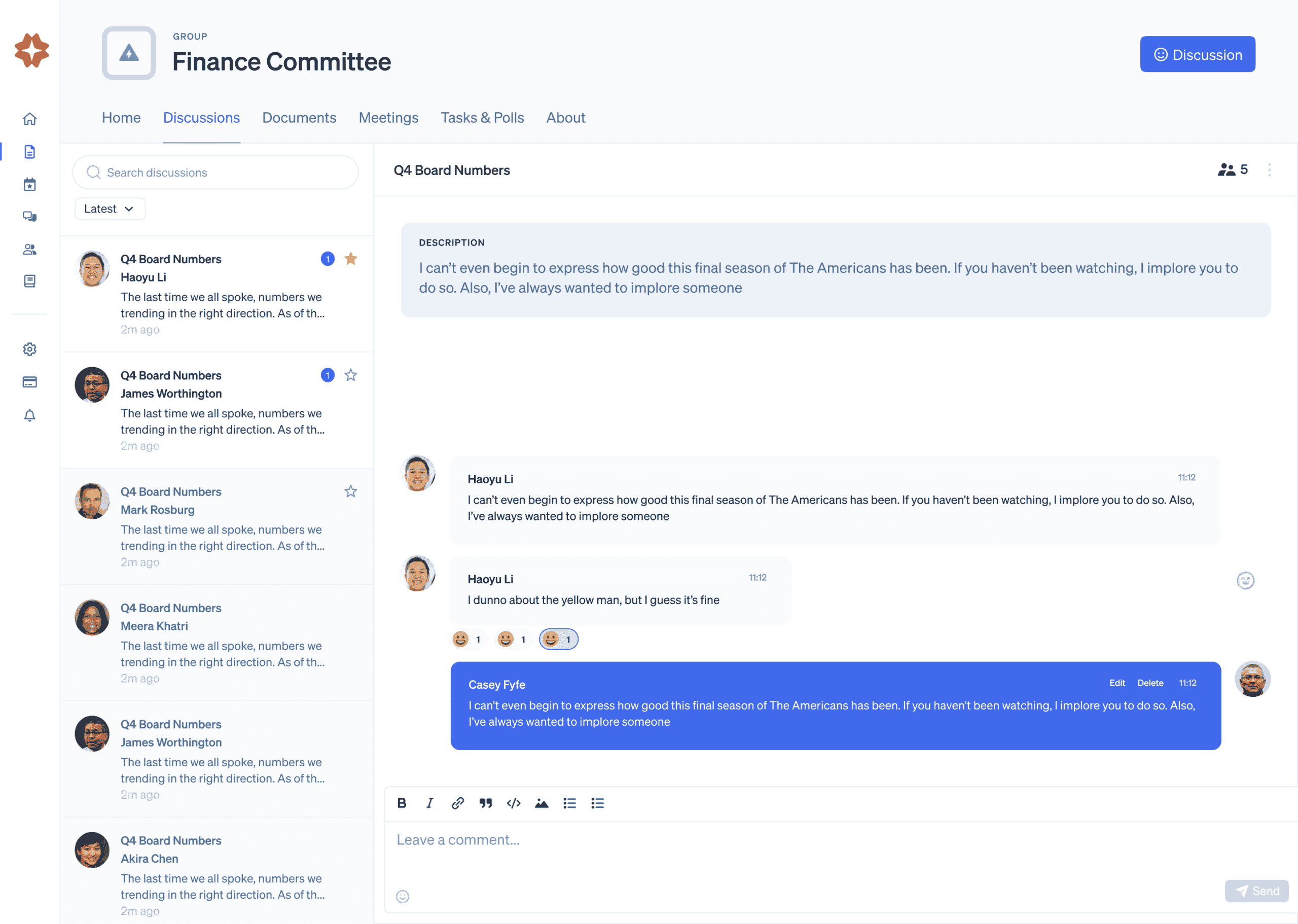If you want to run a successful nonprofit association board, management should be structured so that each board member has their own unique set of responsibilities. Board members behave like a governing body and form a board of directors. So, what are the positions on a board of directors for a nonprofit? At Boardable, we recognize the roles and responsibilities of a board of directors in corporate governance as being divided into four leadership categories: chairperson, vice-chair, secretary, and treasurer. You can learn more about a board of directors’ roles and responsibilities, or keep reading for more information about the role of a board of directors in nonprofit organization settings.
Besides the different leadership positions, you can also have multiple types of board of directors based on the model of board governance you decide to use. We have identified six main types of governance models: advisory, patron, cooperative, policy, community engagement, and hybrid. No matter which board model you choose, there are usually a few common best practices to keep in mind, as following them will help you maintain a proactive board. For example, you can regularly survey your board about its needs, keep job descriptions for the board up to date, form succession plans, and have a way, method, or system you can use to assess the success of your board as a whole.
Additionally, the typical association has specific nonprofit (i.e. 501c3) board of directors’ rules that either focus on resolving issues or answering recurring questions. Some of these policies are based on things like whistleblowing, conflicts of interest, gift acceptance, and item acceptance. A policy that can address potential conflicts of interest is especially crucial if you want to avoid compromising your organization’s trust with the public. Breaking this trust could not only damage your association’s credibility but also stall the momentum towards accomplishing your goals.
Nonprofit Board Structure Chart
The typical nonprofit board structure chart or nonprofit organizational chart is topped by four leadership positions, one of which is the board chair, which oversees the entire board of directors and corresponding committees to make sure the nonprofit is on track to reach its goals. The board chair also takes fiduciary responsibility when it comes to monitoring donations to the organization, large gifts given to the organization, and employee payroll.
Other nonprofit board of directors’ positions in leadership includes vice-chair, secretary, and treasurer. These roles are usually included even in a small nonprofit board structure chart or nonprofit organization structure template. Underneath these leadership roles, board committees can also be formed. The board committee structure, roles, and responsibilities vary based on your board’s needs, and they can help you divide up the workload equally across the board. You might consider that having an appropriate number of committees is one of the multiple best practices of highly effective nonprofit boards because they can make your goals and responsibilities easier to manage.
Association Of Governing Boards
Boards are not confined to only nonprofit organizations. There are lots of industries whose organizations can benefit from forming these boards, such as those in the for-profit, trade, education, and healthcare sectors. These organizations tend to be mission-driven, and they can make use of boards to accomplish their goals.
You may be familiar with the AGB, formally known as the Association of Governing Boards of Universities and Colleges (Glassdoor’s company overview) or simply the Association of Governing Boards. You may also be familiar with a similar organization called the ACCT, whose full name is the Association of Community College Trustees (sometimes referred to as the Association of College Trustees). These are some examples of organizations of governing boards in higher education.
An AGB search turns up the AGB website, which says it is an organization that empowers college, university, and similar boards to engage in association governance confidently. Somewhat of a board of universities, the AGB (and similarly, the ACCT) focuses on supporting each university governing board associated with its organization. These organizations highlight the importance of school boards in general and their impact. This is just one type of candidate that could benefit from a board management solution and use it to improve their school board experience overall.
Association Of Governing Boards Of Universities And Colleges
A simple focused AGB search for the AGB group (the Association of Governing Boards of Universities and Colleges) shows that in some ways, it could be seen as a kind of “board of universities”. The Association of Governing Boards of Universities and Colleges describes itself as an organization that supports a variety of governing boards in higher education by providing resources, hosting educational events, and offering consulting services. The ACCT or Association of Community College Trustees (i.e. Association of College Trustees) is an organization with similar goals.
Circling back to the idea of a board of directors (in the context of nonprofit organizations) previously mentioned, you can also take note that a college governing body is normally called a board of trustees (rather than directors). Even though every board is different and the purpose of each board varies, the typical university board of trustees’ responsibilities and the usual board of directors’ responsibilities are all rooted in practical, legal, and ethical duties. Organizations like the AGB and ACCT exist to support the boards of trustees of different universities so those institutions can check off all of their responsibilities as boards. Likewise, our services are designed to further support educational boards, just on the software front.
10 Basic Responsibilities Of Board Members
You will see that there are several board member roles and responsibilities that show up in both nonprofit and for-profit boards. This rounds out to about 10 basic responsibilities of nonprofit boards or 10 basic responsibilities of board members in general. For most boards, the basic ideas behind nonprofit board member roles and responsibilities are not very different from other board member responsibilities (for-profit organization duties).
To start, what are the 3 primary responsibilities of board members? These basic board member duties, also known as core legal responsibilities, include the duties of care, loyalty, and obedience. For the most part, these duties exist to ensure your board stays trustworthy and effective.
Adding onto these core responsibilities, board members are also expected to follow a few standards:
- Advance the mission of the organization
- Fulfill legal and fiduciary responsibilities
- Prepare for meetings
- Hire and oversee the executive director
- Recruit new members
- Adopt reliable communication tools
- Serve on committees
Beyond these standards, you will also find certain policies connected to nonprofit board of directors’ roles and responsibilities. If you are wondering who should NOT serve on a board of directors, it is safe to assume that it would be anyone who is unable or unwilling to follow these guidelines.
Board Member Roles
As a refresher, what are the 3 primary responsibilities of board members? First, the duty of care is about how members should commit themselves to fulfil their promises and assisting the organization as much as they can. Second, the duty of loyalty highlights how members should also act as ambassadors for the organization by supporting its work and embodying its mission; this includes setting personal interests aside. Third, the duty of obedience says that members are obligated to follow the guidelines of the organization as they are listed in its governance documents.
Nonprofit board of directors positions and board member roles, in general, are heavily influenced by the core tenets or duties we just mentioned. The list of basic board member responsibilities (for-profit organizations excluded) goes on to include the qualities of a good nonprofit board member. This kind of person is:
- Passionate about the cause
- Eager to participate
- Prepared for events
- Excited for committees
- Expressive of ideas
- Curious to learn
- Desires stewardship
- Creative
- Communicative and/or cooperative
Board Member Positions Nonprofit
While the board member responsibilities (for-profit vs nonprofit) may differ from organization to organization, every for-profit and nonprofit board of directors serves as a force of governance above all else. This is the reason why many board member positions (nonprofit and for-profit) in terms of leadership are nearly identical. You can sum up the main for-profit and nonprofit board member roles and responsibilities as the positions of chair, vice-chair, secretary, and treasurer.
Perhaps you are interested in becoming a board member or learning about volunteer board member positions, and you are considering looking up “nonprofit board positions near me”. You may want to keep a few things in mind as you continue along your journey. First, remember the 3 core responsibilities that apply to every board member. Second, know the other 7 standards that a potential board member such as yourself would be expected to follow. When you feel confident and ready to fulfill all of these responsibilities, revisit and review the qualities of a great nonprofit board member. Do these qualities fit your description, character, and personality? If they do, you can move on to thinking about which role you see yourself as being best suited for in your preferred organization.
At Boardable, we understand the roles and responsibilities of a board of directors. This is why we created a board management platform that encompasses the entire meeting lifecycle that will increase board engagement and collaboration. Start free today with Boardable.

